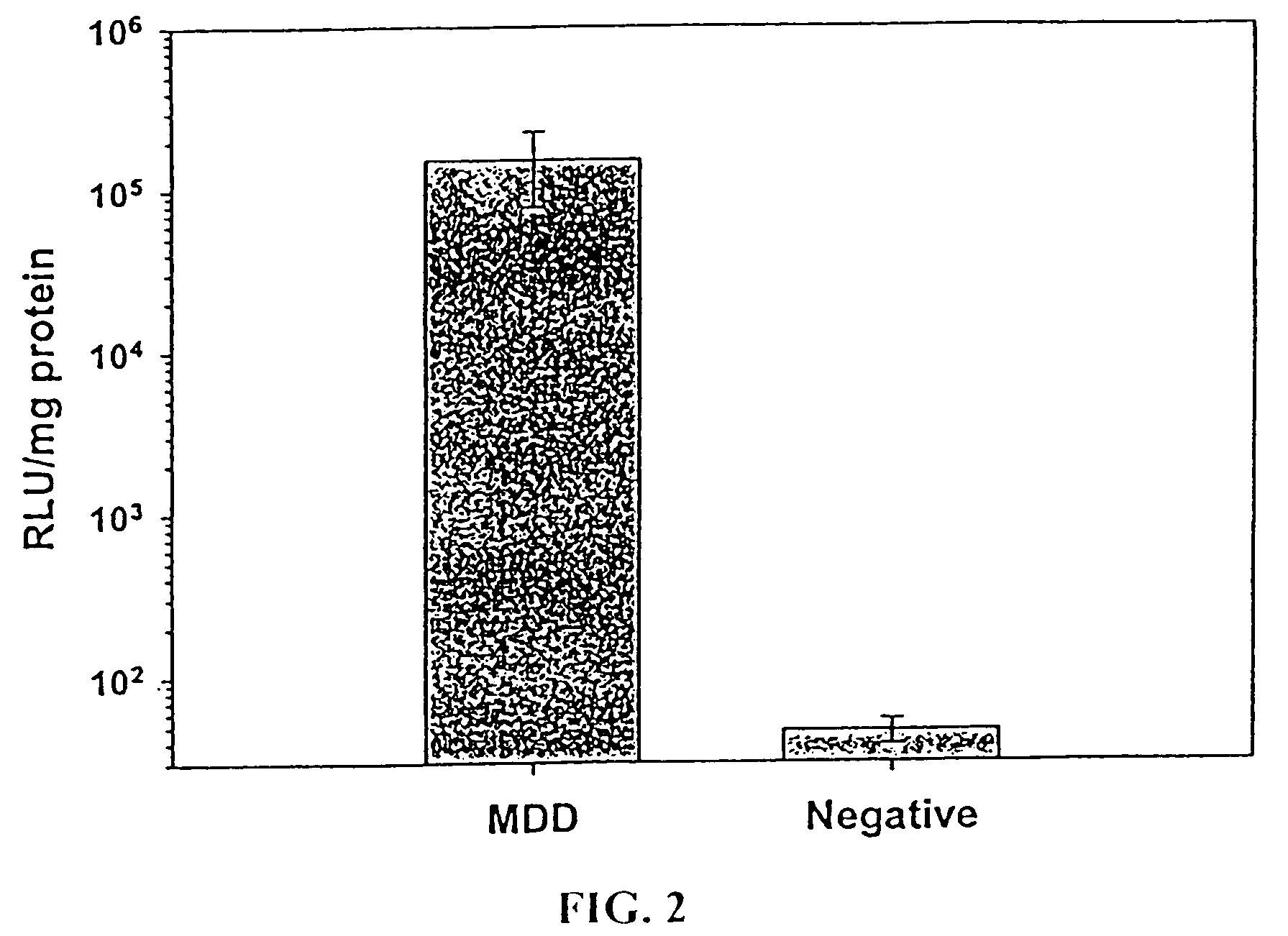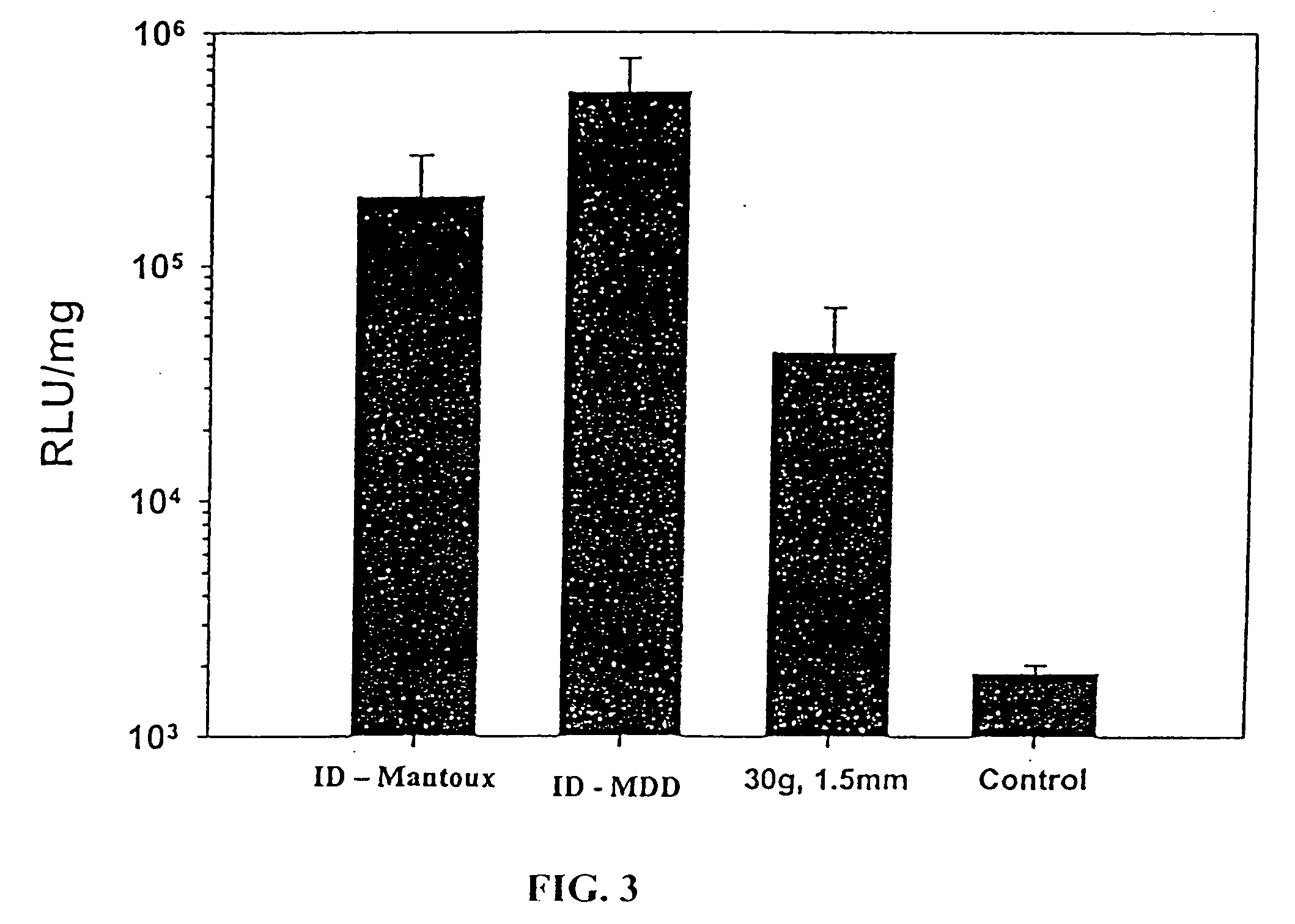Intradermal delivery of vacccines and therapeutic agents
- Summary
- Abstract
- Description
- Claims
- Application Information
AI Technical Summary
Benefits of technology
Problems solved by technology
Method used
Image
Examples
example 1
ID Delivery and Expression of Model Genetic Therapeutic / Prophylactic Agents, Guinea Pig Model
[0104] Uptake and expression of DNA by cells in vivo are critical to effective gene therapy and genetic immunization. Plasmid DNA encoding the reporter gene, firefly luciferase, was used as a model gene therapeutic agent (Aldevron, Fargo, N. Dak.). DNA was administered to Hartley guinea pigs (Charles River, Raleigh, N.C.) intradermally (ID) via the Mantoux (ID-Mantoux) technique using a standard 30G needle or was delivered ID via MDD (ID-MDD) using a 34G steel micro-cannula of 1 mm length (MDD device) inserted approximately perpendicular. Plasmid DNA was applied topically to shaved skin as a negative control (the size of the plasmid is too large to allow for passive uptake into the skin). Total dose was 100 μg per animal in total volume of 40 μl PBS delivered as a rapid bolus injection (<1 min) using a icc syringe. Full thickness skin biopsies of the administration sites were collected 24 h...
example 2
ID Delivery and Expression of Model Genetic Therapeutic / Prophylactic Agents, Rat Model
[0106] Experiments similar (without Mantoux control) to those described in Example 1 above were performed in Brown-Norway rats (Charles River, Raleigh, N.C.) to evaluate the utility of this platform across multiple species. The same protocol was used as in Example 1, except that the total plasmid DNA load was reduced to 50 μg in 50 μl volume of PBS. In addition, an unrelated plasmid DNA (encoding b-galactosidase) injected into the ID space (using the MDD device) was used as negative control. (n=4 animals per group). Luciferase activity in skin was determined as described in Example 1 above.
[0107] The results, shown in FIG. 2, demonstrate very significant gene expression following ID delivery via the MDD device. Luciferase activity in recovered skin sites was >3000-fold greater than in negative controls. These results further demonstrate the utility of the method of the present invention in delive...
example 3
ID Delivery and Expression of Model Genetic Therapeutic / Prophylactic Agents, Pig Model
[0108] The pig has long been recognized as a preferred animal model for skin based delivery studies. Swine skin is more similar to human skin in total thickness and hair follicle density than is rodent skin. Thus, the pig model (Yorkshire swine; Archer Farms, Belcamp, Md.) was used as a means to predict the utility of this system in humans. Experiments were performed as above in Examples 1 and 2, except using a different reporter gene system, β-galactosidase (Aldevron, Fargo, N. Dak.). Total delivery dose was 50 μg in 50 μl volume. DNA was injected using the following methods: (i) via Mantoux method using a 30G needle and syringe; (ii) by ID delivery via perpendicular insertion into skin using a 30 / 31G needle equipped with a feature to limit the needle penetration depth to 1.5 mm; and (iii) by ID delivery via perpendicular insertion into skin using a 34G needle equipped with a feature to limit the...
PUM
| Property | Measurement | Unit |
|---|---|---|
| Mass | aaaaa | aaaaa |
| Mass | aaaaa | aaaaa |
| Mass | aaaaa | aaaaa |
Abstract
Description
Claims
Application Information
 Login to View More
Login to View More - R&D
- Intellectual Property
- Life Sciences
- Materials
- Tech Scout
- Unparalleled Data Quality
- Higher Quality Content
- 60% Fewer Hallucinations
Browse by: Latest US Patents, China's latest patents, Technical Efficacy Thesaurus, Application Domain, Technology Topic, Popular Technical Reports.
© 2025 PatSnap. All rights reserved.Legal|Privacy policy|Modern Slavery Act Transparency Statement|Sitemap|About US| Contact US: help@patsnap.com



